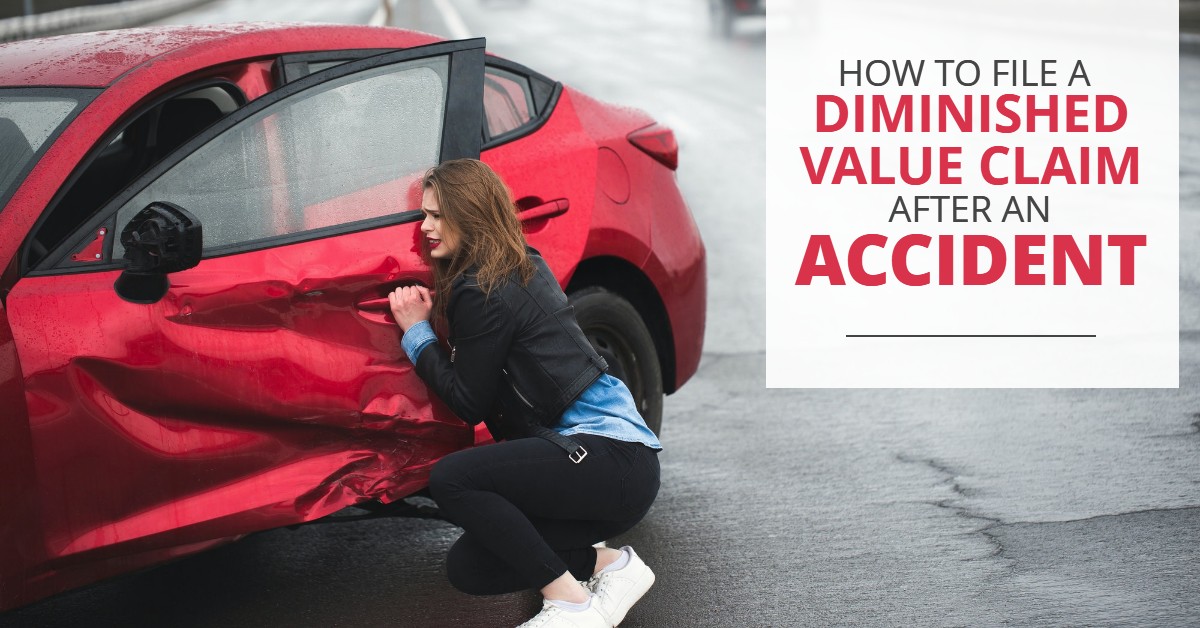Most car owners know that their fancy new wheels will start depreciating the minute they drive off the dealer’s lot. If your new car sustains damage in an accident, its value will plummet even further. Luckily, there are a few ways to avoid losing as much money when this happens.
If another motorist damages your vehicle in an accident, you don’t have to accept a settlement that only pays for repairs without considering vehicle depreciation. In most states, you can file a diminished value claim when you’re not at fault for an accident. Diminished value claims help you recoup your car value, money that you cannot make when you resell it, due to its collision history. Learn what diminished value claims are, how to file one and how to get the best settlement.
What is a diminished value claim?
Typically, when a car sustains damage in an accident, it loses some of its value, particularly if it’s a late model vehicle. In some cases, older model automobiles that sustain light damage may increase in value after repairs, if the repairs include new parts. But that’s not usually the case.
When you purchase car insurance, the carrier may offer you optional replacement cost coverage or OEM parts coverage, which pays for original parts, not third-party equivalents. These optional coverages only apply to repair costs. Even if the insurance company covers all repair costs, your post-repair vehicle has lost some value.
Companies and organizations such as the National Insurance Crime Bureau, autoDNA and AutoCheck provide lookup tools to consumers and used car dealers to help them determine if an automobile has been stolen or has a history of repairs. While the tools help consumers looking for a used vehicle, they work against used car owners seeking to sell their automobiles.
GOT QUESTIONS… JUST CLICK HERE!Once your vehicle is damaged, you’re stuck with its diminished value. However, in certain cases, you can file a diminished value claim to receive compensation for your loss. Usually, auto owners file diminished value claims when they aren’t at fault for an accident. Although the at-fault driver’s insurance company may cover repair costs, the claimant must file a diminished value claim to recoup the lost value.
Types of diminished value claims
The type of diminished value claim you can file will depend on when you file it.
- Immediate diminished value: You can only file an immediate diminished value claim immediately after the accident and before you get your vehicle repaired. If someone slams into your new, pristine car and damages its fender, its market worth instantly decreases, so you need to pursue a diminished value claim. Laws in some states use the immediate diminished value as the primary measure for assessing property damage.
- Inherent diminished value: When seeking compensation after you repair your automobile, you must file an inherent diminished value claim. An inherent diminished value claim compensates you for what insurance companies and used car dealers refer to as “stigma damage.” Stigma damage implies the vehicle’s loss of appeal when compared to an identical automobile with no damage.
- Repair-related diminished value: A repair-related diminished value claim comes into play if the repairer fails to completely repair your vehicle or does a poor job in restoring it to its pre-accident state. For example, if the auto body repair shop left air bubbles in the paint or replaced a fender with one that does not match your car’s color, you could file a repair-related diminished value claim to cover the loss in value.
Suppose your insurance company fails to completely cover the difference between your car’s pre-collision and post-repair values. In that case, you can file a first-party diminished value claim against the insurer. However, in most cases, carriers don’t pay for diminished value on cars they insure. That’s why it’s important to read and understand the limit of liability condition of an insurance policy before you sign an agreement.
GOT QUESTIONS… JUST CLICK HERE!To recoup losses caused by incomplete or shoddy repairs, you can file a third-party diminished value claim. Because many states use immediate diminished value as the primary measure for determining lost value, the burden of compensation usually falls on the insurance company responsible for the claim.
Diminished value laws vary by state, so your chances of winning a first-party or third-party diminished value claim can depend on where you live.
When should you get a diminished value claim?
If you are not at fault for an accident, you should file a diminished value claim with the other driver’s insurance company. According to the Insurance Information Institute, diminished value laws in all states except Michigan require the at-fault drivers insurer to compensate you for the lost value of your vehicle. Typically, the at-fault driver’s property damage liability insurance covers a diminished value claim.
If an uninsured or underinsured driver is at fault for the accident, you can file a diminished value claim against your uninsured and underinsured driver policy, if you have one. Some states require all automobile owners to carry uninsured and underinsured driver coverage. Even if it’s not required in your state, it provides an added layer of protection, especially if you own a late model car that could lose substantial value due to a collision.
How to file a diminished value claim
When submitting a diminished value claim, you’ll need some supporting information first. Use a tool such as the Kelly Blue Book website to find the car’s value before the accident. To do this, you’ll need to have a few necessary details, like what the make and model of your vehicle is, what kind of condition it was in before the accident, and how many miles it had. While the burden of proof can vary by state, it’s wise to gather these details yourself even if your vehicle will be getting a third-party appraisal later. Let’s walk through the process of how to submit a diminished value claim, step-by-step.
- Look up your vehicle’s pre-accident value on Kelly Blue Book website, or a similar site.
- Double-check your state laws on diminished value claims.
- Contact the insurance company of the at-fault driver.
- Inform an agent of that insurance company that their insured driver was at-fault in an auto accident with you and that you are contacting them to file a diminished value claim.
- Cooperate with the agent’s request for information and verification. At this point, they will likely want to have the condition of the vehicle inspected by an expert.
- Wait on the determination of the insurance company as they complete their process.
Filing diminished value in my state
The laws around diminished value claims vary by state. However, it’s common for states to allow the not-at-fault driver to file a diminished value claim following an auto accident. The main differences between state laws are how they calculate the diminished value, who can file the claim, how long after the accident this claim can be filed, and what form and amount the financial compensation will take. For example, in Massachusetts, an insurance company does not have to pay diminished value if they repair or replace the vehicle. The counter to this approach is in states like Maryland, where the law says that if there is still diminished value after repairs, the insurance company must cover that difference.
GOT QUESTIONS… JUST CLICK HERE!Fifteen states have stated that drivers may obtain diminished value from the insurance company of the at-fault driver. These states are Arizona, Colorado, Florida, Georgia, Illinois, Indiana, Iowa, Kansas, Louisiana, Maryland, New Mexico, New York, Oregon, South Carolina, and Virginia. However, all states, except for Michigan, allow for some degree of diminished value claims when another driver is at fault.
How diminished value claims are calculated
Most insurance companies calculate diminished value using formula 17c. “17c” refers to the paragraph and section of a Georgia court case — State Farm Mutual Automobile Insurance Company v. Mabry — which establishes the formula. Insurers like using formula 17c because it produces a lower diminished value than other methods.
- Using Kelly Blue Book or NADA tools, determine the market value of your vehicle, post-collision.
- Multiply the value by .10 to calculate the base loss value. For example, if the market value is $12,000, the base loss value will be $1,200.
- Multiply the base loss value by one of the following multipliers:
- 1 for damage to the car’s structure
- 0.75 for major panel or structure damage
- 0.50 for moderate panel or structure damage
- 0.25 for minor panel or structure damage
- 0.00 for no structure damage
- Now apply another multiplier, based on the car’s mileage, to the adjusted base loss value:
- 1 for 0 to 19,999 miles
- 0.80 for 20,000 to 39,999 miles
- 0.60 for 40,000 to 59,999 miles
- 0.40 for 60,000 to 79,999 miles
- 0.20 for 80,000 to 99,999 miles
- 0.00 for 100,000+ miles
For instance, if your automobile has 49,000 miles the calculation would be 300 x 0.60 = 180. Using the 17c formula, the insurance company would offer you a $180 diminished value settlement.
How to get the most money out of your diminished value claim
If the 17c formula confused you, you’re not alone. Can it produce an accurate and fair diminished value estimate? No.
That’s why it’s so important for you to do your homework. Run your own diminished value calculations, and get an appraisal from a qualified appraiser. Chances are, the insurance company will low-ball you, offering a settlement based on formula 17c calculations, so you’ll have to negotiate for a higher payment.
To determine a more accurate estimate of the diminished value, use one of the following formulas:
- Determine the value of your car before the accident using the Kelly Blue Book or NADA tools and multiply that value by 0.33. For instance, if the pre-crash value was $15,000, the calculation would be $15,000 x 0.33 = $4,950, which represents the amount of diminished value.
Calculate the diminished value by looking up the car’s pre-crash and post-crash values and adjusting it for the condition of the vehicle. If the pre-accident value was $15,000 and the post-accident value is $11,000, the calculation would be $15,000 – $11,000 = $4,000, which represents the car’s diminished value.
These methods offer a more accurate estimate of your automobile’s actual diminished value. Factors that can impact the amount of a diminished value settlement include:
- Your car’s age and mileage
- Your car’s make and model
- Your location
- Your car’s accident history
It’s important to understand your automobile’s true value before filing a diminished value claim. If your car is a current year model, you can demand a higher settlement than for a car that’s been on the road a few years. Likewise, if your vehicle has sustained damage in previous accidents, you can’t expect a high diminished value settlement for the most recent crash.
To receive the highest settlement, you probably need to hire an attorney to negotiate with the insurance company’s claims adjuster. The role of the claims adjuster is to negotiate the lowest settlement for the insurance company, not the fairest payment to you. Hiring a lawyer to handle the process can lead to a better settlement, not to mention fewer headaches.
Article reference:
https://www.thesimpledollar.com/








